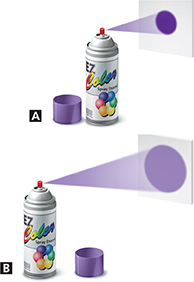Intensity
The closer you are to a source of light, the brighter the light appears. If you want to read at night, you must sit near a lamp. At night, as you walk away from a street light, the area around you becomes darker. A street light doesn't give off less light when you move farther from it. It just provides you with less light the farther away you are. Photons travel outward from a light source in all directions. Near the light source, the photons spread through a small area, so the light is intense. Intensity is the rate at which a wave's energy flows through a given unit of area. You can think of intensity as brightness. Farther from the source, the photons spread over a larger area.  The intensity of light decreases as photons travel farther from the source.
The intensity of light decreases as photons travel farther from the source.
Figure 7 The closer you are to a surface when you spray paint it, the smaller the area the paint covers and the more intense the paint color looks. Using Models How does a can of spray paint help you model a change in light intensity?
 d
dA can of spray paint can help you model a change in light intensity. Look at Figure 7. When the nozzle is close to a piece of paper, the paint forms a small, dense spot. When the nozzle is farther from the paper, the paint forms a larger, fainter spot because the paint is sprayed over a larger area. Like paint on paper, light intensity decreases as distance from the light source increases.
A wave model for light also explains how intensity decreases with distance from a source. As waves travel away from the source, they pass through a larger and larger area. Because the total energy does not change, the wave's intensity decreases.
Section 18.1 Assessment
Reviewing Concepts
 What produces electromagnetic waves?
What produces electromagnetic waves? How fast does light travel in a vacuum?
How fast does light travel in a vacuum? What makes electromagnetic waves different from one another?
What makes electromagnetic waves different from one another? Explain how light behaves like a stream of particles.
Explain how light behaves like a stream of particles. What happens to the intensity of light as photons move away from the light source?
What happens to the intensity of light as photons move away from the light source?How does photon energy relate to frequency?
Critical Thinking
Applying Concepts Why does blue light cause emission of electrons from metal while red light does not?
Observing Describe what happens as you get closer to a light source. Explain this observation.
Math Practice
What is the wavelength of an AM radio wave in a vacuum if its frequency is 810 kilohertz?
A global positioning satellite (GPS) transmits a signal at a frequency of 1575 megahertz. What is the wavelength? (Hint: Assume the wave speed is the same as in a vacuum.)




